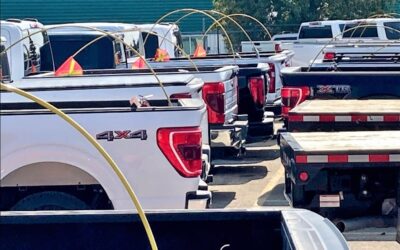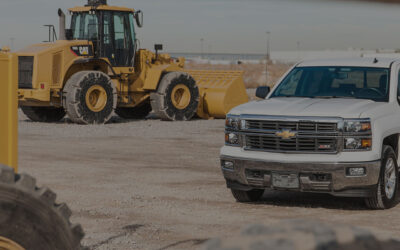How Driving Ergonomics Can Improve Fleet Drive Performance
A fleet manager has various challenges to deal with, such as fleet safety, driver performance, and truck ergonomics. The former two can be ensured and boosted by investing in the right driving ergonomics. Finding the right ergonomic specs for your trucks to meet the diverse operating needs of a fleet’s workforce can be a bit daunting, but it’s surely worth it.
Truck driving ergonomics needs to be a high priority for any fleet manager. After all, they can impact the bottom line of the business by improving driver performance and productivity and reducing comp costs. They can also reduce the occurrence of fatigue-induced operator errors that can have disastrous consequences.
According to the Bureau of Transportation Statistics, fleet drivers are more likely to exceed the average commute time. As we are aware, being in a cramped place for an extended period is going to do some harm to the driver’s body. Fleet supervisors are now taking the drivers’ safety more seriously than ever. It’s important to know how to make these drivers comfortable while they are getting the work done.
Understanding Good Driving Ergonomics
The best way to design more ergonomic and driver-friendly vehicles is to proactively identify the existing problems and remedy them before they impact employee morale and cause health issues. If ergonomics are not dealt with and improved, they can also lead to preventable accidents. This is because they reduce driver comfort, thus leading to fatigue, which in turn causes accidents due to impaired cognitive function.
Fleet drivers utilize their trucks much like a workstation or office. This is why driving ergonomics must be designed to provide comfort and safety. Their workspace needs to be designed to reduce strain and stress on their bodies if they’ll be in the same position for a prolonged amount of time. Operator safety and ease of use must be your primary goals. You can only work on these parameters if you work closely with field workers and observe their normal work processes to figure out the hindrances in their way. This will help you design a driving ergonomic-friendly vehicle.
Invest in Ergonomic Upfit Equipment
At times, drivers or field operators modify vehicles in the field without letting the fleet manager know. The home office only finds out when a complaint is issued related to ergonomics-related health problems or if an accident occurs. Field workers should actively inspect all the fleet vehicles regularly and also keep a check on the upfit equipment to ensure fleet safety. Moreover, field workers and fleet drivers should report any equipment damage or failure right away.
Oftentimes, fleets have to deal with negligence allegations against their upfit specifications that caused pulling, pushing, bending, or lifting injuries. Complaints against equipment that’s deemed to be “less-than-ergonomic” can often result in costly litigations.
This is why fleet managers need to ensure that the upfits in their vehicles are ergonomically designed so that operators can use them safely and without injuring themselves. If this isn’t taken care of, then fleets will continue to deal with expensive workers’ compensation claims made by equipment operators. Moreover, fleet drivers and your business will continue to suffer.
Provide Ample Cabin Space to Your Drivers and On-Field Workers
With the expansion and evolution of the fleet industry, work trucks have slowly evolved into mobile offices that are equipped with high-quality in-cab devices. These include mobile data terminals for routing, job-site reporting, and work orders, as well as swivel writing boards and in-cab filing bins. These devices are there to enhance the productivity of drivers and ensure a good bottom line for the business.
However, these devices also take up the already-limited cabin space and can restrict a driver’s body movements, which can result in ergonomic injuries over time. This is because employees are often required to use small touch screens and keyboards to input on-field data while sitting in a cramped truck cab.
This often leads drivers to complain of carpal tunnel syndrome due to the bad posture that they are required to take up while entering the data in the field. This is why field workers and drivers need to have an adequate workspace for proper wrist support. They should also be provided with other ergonomic accessories so that they don’t develop carpal tunnel syndrome or wrist strain.
Selecting the Right Driving Ergonomic Equipment
When selecting unfit equipment for your field vehicles, focus on providing ergonomic solutions to your workers. Focus on parameters such as user body posture to understand the health issues that might crop up due to the work environment.
Always ask the on-field workers multiple follow-up questions to make sure that the equipment they’re using is suitable for the job they’re tasked with daily. Moreover, make sure to train your employees to handle the equipment appropriately and safely.
Additionally, ensure that the user group field managers are regularly inspecting the equipment to ascertain that it’s in optimal working condition and is being used for its intended purpose only. It’s best if you create clear written guidelines for vehicle and equipment use and instruct your operators to follow the manufacturer’s guidelines to ensure fleet safety.
Here is some ergonomic equipment that you can retrofit into your fleet vehicles:
- Roll-Up Doors: Make sure that your cargo body has a roll-up door that operators can reach from the ground.
- Ladder Rack That Drops Down: Always specify that you want a drop-down-style ladder rack for your vans. This will boost operator efficiency and help prevent possible back issues that your drivers would have had to face from pulling a 24-foot extension ladder from the roof of the vehicle.
- Safety Tread Step: If it tends to snow a lot in your area, then invest in an open safety tread step rather than closed running board steps. The anti-slip coating of the safety tread will ensure that your workers don’t slip.
- Slide-Out Bed: If your pickups have commercial-style caps, then add bed sliders to them so that your operators don’t have to twist or bend to remove objects from the truck bed.
- Grab Handle and Rear Step Bumper: Opt for an open strut-style rear bumper to minimize slips from collected snow or rainwater. Add a grab handle to facilitate your workers so that they can easily get in and out of the service body bed.
- Side-Door Access: Always add side-door access to your vans so that your workers can work inside the body of the van during rough weather.
- Liftgates: Add liftgates to prevent the risk of back injuries. They will allow operators to load, move, or unload heavy objects in and out of their vehicles.
- Pull-out Ramps: Add ventilated ramps that you can pull out to expedite the removal of bulky objects from the dolly. The ventilated slits will stop snow and rain from pooling on the ramp surface.
Driving Ergonomic Tips:
It has been found that fleet drivers who are ignoring ergonomic suggestions are experiencing long-term injuries. This includes injuries to the neck, shoulder, hands and back. Other noticeable problems are cramps and pressure points in the legs, lower back injuries, and even damage to the spinal disc. However, there are steps to prevent these injuries:
- Keep your seat tilted at a 110-degree angle from your legs
- This minimizes additional pressure on the spinal disc.
- When traveling in vehicles that vibrate, tilt your seat slightly every 20 mins
- Vibrations can cause changes in bones and joints, tendons, muscles, and even the nervous system.
- Take breaks to walk around
- If you’re on the road for two or more hours, getting out and walking/stretching can help circulate blood flow.
- Adjust your mirrors
- If they are in the right position and you start slouching, it’s a cue to sit back up.
In addition to these types of injuries, many happen outside of the car. The most common place for injuries for fleet drivers is loading and unloading heavy cargo.
What to Avoid When Loading/Unloading
- Don’t bend down/over while standing in the bed to pick things up. This will put pressure on your lower back and shoulders.
- Don’t attempt to reach for cargo too far or low into the bed of the fleet truck.
- Don’t twist your body into awkward positions to avoid stress on your spine.
- Don’t store items in the backseat – this can cause uncomfortable twisting while trying to retrieve something in the back.
It’s the responsibility of fleet managers to make sure their fleet drivers are following these simple steps to make sure they are not putting their bodies in jeopardy. Fleet managers can help by making sure their crew has the proper training. Many fleet managers will also supervise the loading and unloading firsthand to make sure it’s being done correctly. If that’s not enough, components such as fold-out steps, work benches, tailgates, and even drop-down systems can be added to make loading/unloading simpler. This will decrease the loss of employees due to injury and will increase their productivity.
Do everything in your power to ensure that your vehicles are as ergonomic and user-friendly as possible and opt for equipment that’s perfect for the specific requirements of each vehicle. This will help boost driver performance, ensure fleet safety, and help you achieve your bottom line! Summit Fleet understands that you want to get the job done fast. That’s why we provide ergonomic tips and flexible fleet rentals with the appropriate setup to get the job done. Learn more about our trucks here.
Source:






